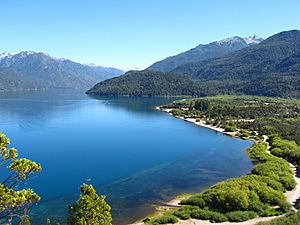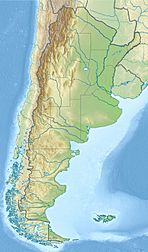Puelo Lake facts for kids
Quick facts for kids Puelo LakeLago Puelo |
|
|---|---|
 |
|
| Location | Cushamen Department, Chubut Province, Argentina, in Patagonia |
| Coordinates | 42°9′55″S 71°38′13″W / 42.16528°S 71.63694°W |
| Type | glacial |
| Primary outflows | Puelo River |
| Catchment area | 3,040 square kilometres (1,170 sq mi) |
| Basin countries | Argentina |
| Max. length | 19 kilometres (12 mi) |
| Max. width | 2.5 kilometres (1.6 mi) |
| Surface area | 44 square kilometres (11,000 acres) |
| Average depth | 111 metres (364 ft) |
| Max. depth | 180 metres (590 ft) |
| Water volume | 4.9 cubic kilometres (4,000,000 acre⋅ft) |
| Residence time | one year |
| Surface elevation | 192 metres (630 ft) |
| Settlements | Lago Puelo |
Lake Puelo (also known as Lago Puelo in Spanish) is a beautiful lake found in the northern part of Chubut Province, a region in Argentine Patagonia. This lake was formed by glaciers and rivers, making it very deep, reaching up to 180 meters (about 590 feet) at its deepest point. It has a unique L-shape and is completely surrounded by the amazing Lago Puelo National Park.
Contents
Lake Puelo: A Natural Wonder
Lake Puelo is a stunning natural area in Argentina. It's a popular spot for tourists who want to enjoy nature. The lake's clear waters and the green forests around it make it a special place to visit.
How Was Lake Puelo Formed?
Lake Puelo has a "fluvial-glacial" origin. This means it was shaped by both rivers and ancient glaciers. Imagine huge sheets of ice slowly moving and carving out the land. As the glaciers melted, they left behind the deep basin that filled with water, creating the lake we see today.
Rivers and Water Flow
The lake gets its water from smaller rivers like the Azul and Quemquemtreu. The water then flows out of Lake Puelo through the Puelo River. This river is quite special because it travels all the way to the Pacific Ocean! It flows through a narrow, fast-moving section called Arroyo los Hitos. After this, the water enters Lake Puelo Inferior (Lower Puelo Lake), which is entirely in Chile.
Unique Forests Around the Lake
The area around Lake Puelo is covered by a special type of forest called the Valdivian temperate rain forests. These forests are usually found closer to the coast in Chile, where there's more rain from the ocean. It's a bit unusual to find them on the eastern side of the Andes mountains in Argentina, making the scenery around Lake Puelo even more unique and beautiful. You'll see lots of green trees and plants here.
What Does "Puelo" Mean?
The name "Puelo" comes from the language of the Mapuche people, who are the native inhabitants of this region. In their language, Mapudungun, "puel" means "east" and "co" means "water." So, "Puel-có" means "Water at the East." This name makes sense because the lake was located on the eastern side of the Mapuche territory.
The Town of Lago Puelo
Just about 5 kilometers (3 miles) north of the lake is the town of Lago Puelo. This town is located in the narrow valley of the Azul River. The main activity and business in the town and the surrounding area is tourism. Many people visit to enjoy the lake, the national park, and the beautiful natural environment.
See also
- In Spanish: Lago Puelo para niños


